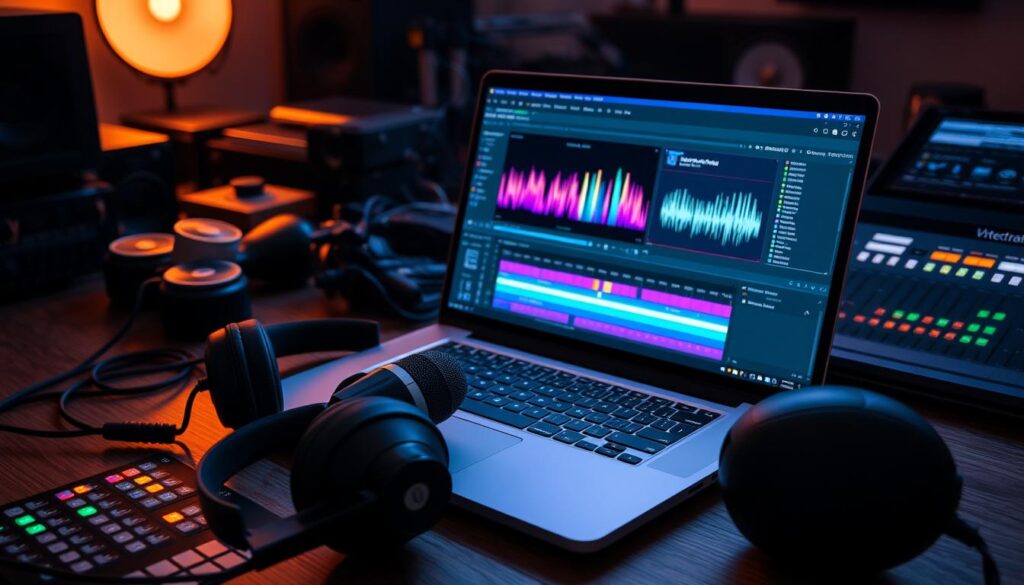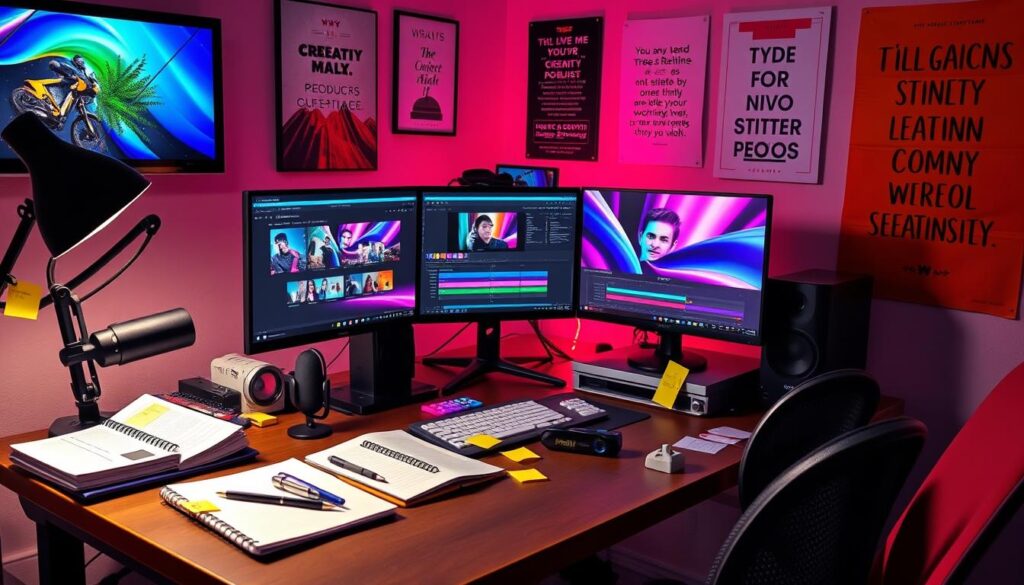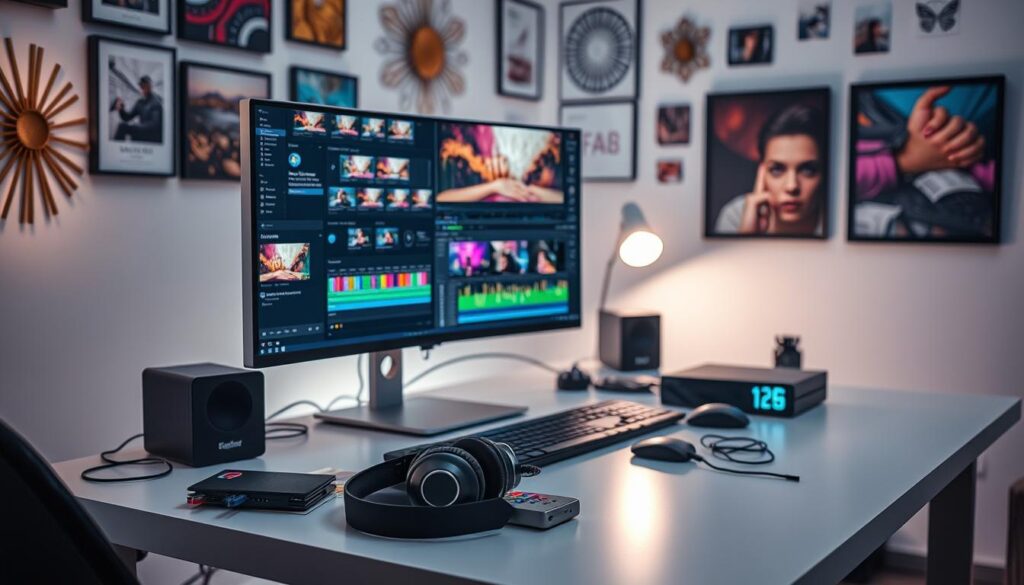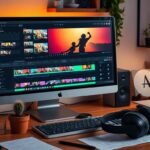In today’s world, making great video content is very important. It’s key for anyone who wants to be a filmmaker, content creator, or a business looking to boost their marketing. This guide will show you how to improve your video editing skills. You’ll learn a lot about video editing tutorials and how to make your videos stand out.
Key Takeaways
- Discover a wide range of online video editing tutorials catering to different skill levels
- Learn professional-grade editing techniques, including cutting, trimming, and applying transitions and special effects
- Explore color grading and audio editing strategies to elevate the visual and auditory elements of your videos
- Understand the video editing workflow, from understanding the timeline to optimizing videos for various platforms
- Access a wealth of resources, including online courses, communities, and forums, to further enhance your video editing skills
Mastering Video Editing Basics
Crafting captivating videos starts with understanding video editing basics. You’ll learn about popular video editing software and the video editing timeline. This will help you improve your video editing workflow and make your videos stand out.
Introduction to Video Editing Software
The world of video editing is vast, with many software options. Top tools like Adobe Premiere Pro, Final Cut Pro, and DaVinci Resolve have lots of features. Knowing what each tool can do will help you pick the best one for your projects.
Understanding the Video Editing Timeline
The video editing timeline is key to editing videos. It helps you organize and refine your footage. Learning how to use the timeline will make your videos look professional and smooth.
“The key to effective video editing is understanding the tools at your disposal and how to leverage them to tell a compelling story.”
Learning about video editing software and the timeline is the first step. With these skills, you’ll be ready to create videos that grab attention and tell great stories.
Essential Video Editing Techniques
To make your videos better, you need to learn the key video editing techniques. This includes cutting and trimming footage well and adding transitions and special effects smoothly. Each part is important for creating a great video.
Cutting and Trimming Footage
Cutting footage is the base of video editing. It’s about picking and perfecting each clip to tell a story that grabs viewers. Cutting out extra parts, adjusting clip lengths, and tweaking the speed make your video better.
Transitions and Special Effects
Using transitions and special effects takes your videos to the next level. They help move scenes smoothly and add cool visual and audio touches. These elements make your video more engaging and impactful.
“The true magic of video editing lies in the ability to transform raw footage into a captivating cinematic experience.” – John Doe, award-winning video editor
Learning these video editing techniques will help you make videos that grab attention. Whether you’re new to video making or have been doing it for years, these skills will improve your work.
Color Grading and Color Correction
Learning to master color grading and color correction can change how your videos look and feel. This skill lets you tweak the color temperature, balance tones, and add creative color styles. It makes your footage more engaging for your audience.
Color grading is about changing video colors to match a mood or style. You can adjust the brightness, contrast, and color of each channel. Or, you can use filters and LUTs to change the look of your video. This way, you can create a specific atmosphere and guide the viewer’s focus.
Color correction, however, is about making sure colors look right and consistent in your video. It fixes any color problems that happened during filming or early editing. By fixing these issues, you get a more natural and polished look. This is key for effective color grading.
Whether you’re new or experienced in video editing, learning color correction and color grading can make a big difference. With the right tools and skills, you can turn your videos into something truly special. This will grab your audience’s attention and leave a memorable impression.
| Color Grading | Color Correction |
|---|---|
| Manipulating colors for creative effect | Ensuring accurate and consistent color representation |
| Adjusting saturation, contrast, and hue | Correcting color imbalances and white balance issues |
| Applying color-based filters and LUTs | Achieving a more natural and professional-looking result |
| Evoking emotions and setting the tone | Laying the foundation for effective color grading |
Audio Editing for Video Projects
In video production, audio is key to a polished final product. It’s about adding background music and sound effects. This can make your videos stand out. Let’s dive into the art of audio editing and learn how to enhance your video projects.
Adding Background Music and Sound Effects
Background music sets the mood and guides the viewer. Choosing the right music and sound effects can make a big difference. Try different genres to find the perfect fit for your video.
Adjusting Audio Levels and Removing Noise
Good audio levels are essential for a balanced mix. Adjusting dialogue, music, and sound effects makes your audio sound professional. Also, learning to remove background noise can improve your video’s audio quality.
| Audio Editing Techniques | Benefits |
|---|---|
| Background Music Selection | Sets the mood, enhances emotions, and guides the viewer’s experience |
| Sound Effects Integration | Adds depth, realism, and a professional touch to your videos |
| Audio Level Adjustment | Ensures a well-balanced and harmonious audio mix |
| Noise Reduction | Improves overall audio quality and clarity |
Mastering these audio editing techniques can boost your video’s production value. Audio is a vital part of any video. So, spend time improving your audio editing skills to make your videos engaging.

Video Editing Tutorials: Best Practices and Workflow
Making great videos is more than just knowing how to edit. It’s about having a smooth and efficient workflow. We’ll share top tips from pros to help you improve your video editing skills. This will take your projects to the next level.
Organize Your Files and Project
Good video editing starts with a clean project setup. Create a clear file system, grouping your footage, graphics, and audio. Use clear file names and folders to keep your workspace neat and organized.
Optimize Your Editing Process
- Learn keyboard shortcuts to edit faster.
- Stick to a routine for reviewing and perfecting your edits.
- Use software features like custom workspaces and preset effects to make editing easier.
Collaborate Seamlessly
Video editing often means working with a team. Use tools like cloud storage, version control, and feedback systems for smooth teamwork. This keeps your project on track and your team in sync.
Plan and Prioritize
Good video editing needs planning and focus. Before editing, outline your goals, make a shot list, and plan your story. This saves time and effort later on.
Improving at video editing means always looking to refine your workflow. Adopt best practices that fit your projects and style. By doing this, you’ll make editing more efficient, fun, and productive.
Advanced Video Editing Skills
As you get better at video editing, learning advanced techniques can make your work stand out. You can explore motion graphics and animation, and also green screen and compositing.
Motion Graphics and Animation
Motion graphics and animation can really make your videos pop. They help create cool title sequences, smooth transitions, and amazing visual effects. With tools like After Effects or Blender, you can learn to make your own motion graphics and animations. This adds depth and interest to your projects.
Green Screen and Compositing
Working with green screen and compositing is key for advanced skills. It lets you place your subjects in different places, mix in computer graphics, and add visual effects. By learning about keying, rotoscoping, and advanced masking, you can blend elements smoothly into your videos.
| Technique | Application | Benefits |
|---|---|---|
| Motion Graphics | Title sequences, transitions, visual effects | Adds dynamic visual interest and professional polish |
| Animation | Character animation, data visualization, abstract motion | Brings ideas to life and enhances storytelling |
| Green Screen | Compositing subjects into different environments | Enables creative control and flexibility |
| Compositing | Blending multiple video and graphic elements | Produces visually-striking and seamless results |
Learning these advanced techniques can really boost your video editing skills. It lets you make videos that are more dynamic, visually appealing, and professional. Keep practicing and learning to improve your video editing skills.
“The beauty of video editing is that it’s like building a puzzle. You take all these different pieces and pull them together into one whole work of art.”
Optimizing Videos for Different Platforms
As a video creator, it’s key to know how to make your videos work on various platforms and devices. This part will look at the importance of video formats and resolutions. We’ll also cover the best ways to export and render your videos. This ensures they look great and work well on many platforms.
Video Formats and Resolutions
The format and resolution of your video can really change its quality and how well it works. Popular formats include MP4, AVI, and MOV. Each has its own strengths and works best with certain devices and platforms. Also, resolutions like 1080p, 4K, and 8K can impact your video’s look and size.
It’s important to know the good and bad of different formats and resolutions. For example, a 4K video might not be the best for a small mobile screen. But, a lower-resolution video might not look good on a big, high-definition screen.
Exporting and Rendering Videos
After editing your video, you need to export and render it for sharing. This means making the file smaller, adjusting the bitrate, and picking the right codecs. Good video exporting and rendering can keep your video quality high while making it easier to share online.
By learning how to optimize your videos, you can make sure they look and work great everywhere your viewers watch them.
Video Editing Resources and Tutorials
Aspiring video editors have a wealth of online resources at their fingertips. From comprehensive video editing courses to interactive tutorials and vibrant communities, there’s no shortage of opportunities to enhance your skills and stay up-to-date with the latest trends and techniques.
Online Courses and Tutorials
Explore a diverse range of online video editing courses that cater to various skill levels and interests. These immersive learning experiences can provide in-depth instruction on industry-leading software, such as Adobe Premiere Pro, Final Cut Pro, and DaVinci Resolve. Whether you’re a beginner looking to master the fundamentals or an experienced editor seeking to expand your capabilities, these online courses offer structured learning paths to help you achieve your goals.
In addition to formal courses, a plethora of video editing tutorials are available online, covering a wide array of topics. From quick tips and tricks to in-depth walkthroughs, these tutorials can be invaluable resources for honing your craft and staying informed about the latest advancements in the field.
Video Editing Communities and Forums
Connecting with like-minded individuals in video editing communities and forums can provide a wealth of support, inspiration, and collaborative opportunities. These online hubs serve as platforms for sharing knowledge, discussing industry trends, and receiving feedback from experienced professionals and enthusiasts. Engaging with these communities can help you stay motivated, learn from others, and potentially even find opportunities for collaboration or mentorship.
| Online Video Editing Courses | Video Editing Tutorials | Video Editing Communities |
|---|---|---|
| Udemy: Video Editing Masterclass | Premiumbeat: 50 Video Editing Tips | Reddit r/VideoEditing |
| Skillshare: Intro to Video Editing | PremiumBeat: Color Grading Tutorials | Creative Cloud Community |
| Coursera: Video Production Specialization | Motionarray: Premiere Pro Tutorials | The Editor’s Lounge |
By tapping into these diverse video editing resources, aspiring and experienced editors alike can continue honing their skills, staying informed about industry developments, and connecting with a vibrant community of fellow creatives.

Conclusion
In this guide, you’ve learned key skills for mastering video editing through online tutorials. You now know the basics of video editing software and advanced techniques like color grading and audio editing. You’re ready to make engaging, professional video content.
You’ve also learned about the video production process. This knowledge helps you improve your video production skills. Use online courses and video editing communities to keep improving. This will help you stay up-to-date in the digital media world.
Start your journey to become a skilled video editor. Show off your new skills in the videos you make. The possibilities are endless. With hard work and dedication, you can create stunning video content that grabs your audience’s attention.



